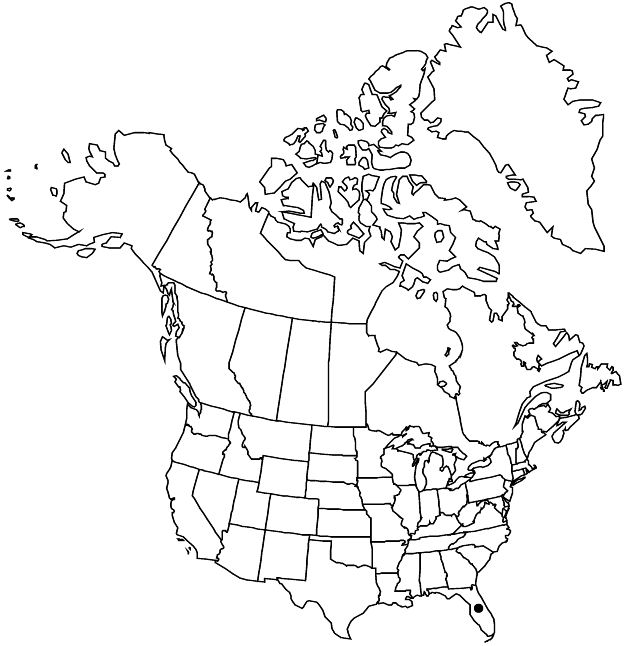Difference between revisions of "Linum arenicola"
Nat. Pflanzenfam. ed. 2, 19a: 116. 1931.
FNA>Volume Importer |
FNA>Volume Importer |
||
| Line 34: | Line 34: | ||
|elevation=0–10 m. | |elevation=0–10 m. | ||
|distribution=Fla. | |distribution=Fla. | ||
| − | |discussion=<p>All parts of Linum arenicola flowers are yellow; the stamens are held close to the styles, with anthers at the same level as stigmas. The staminodia are low, deltoid, and less than 0.5 mm. Linum arenicola is only known from about nine sites in Miami-Dade County and the Florida Keys in Monroe County. Its habitat of pine rocklands has been almost completely destroyed by urban development and altered fire regimes. J. R. McDill (2009) reported that L. arenicola grouped with L. rupestre (southwestern United States), L. flagellare (Small) H. J. P. Winkler (southcentral Mexico), and L. bahamense Northrop (Bahamas), all perennials with many branches arising from a woody taproot or caudex. Linum arenicola and L. bahamense both occur on calcareous soils, and C. M. Rogers (1984) considered them to be closely related.</p> | + | |discussion=<p>All parts of <i>Linum arenicola</i> flowers are yellow; the stamens are held close to the styles, with anthers at the same level as stigmas. The staminodia are low, deltoid, and less than 0.5 mm. <i>Linum arenicola</i> is only known from about nine sites in Miami-Dade County and the Florida Keys in Monroe County. Its habitat of pine rocklands has been almost completely destroyed by urban development and altered fire regimes. J. R. McDill (2009) reported that <i>L. arenicola</i> grouped with <i>L. rupestre</i> (southwestern United States), L. flagellare (Small) H. J. P. Winkler (southcentral Mexico), and L. bahamense Northrop (Bahamas), all perennials with many branches arising from a woody taproot or caudex. <i>Linum arenicola</i> and L. bahamense both occur on calcareous soils, and C. M. Rogers (1984) considered them to be closely related.</p> |
|tables= | |tables= | ||
|references= | |references= | ||
| Line 58: | Line 58: | ||
|publication year=1931 | |publication year=1931 | ||
|special status=Endemic;Conservation concern | |special status=Endemic;Conservation concern | ||
| − | |source xml=https://jpend@bitbucket.org/aafc-mbb/fna-data-curation.git/src/ | + | |source xml=https://jpend@bitbucket.org/aafc-mbb/fna-data-curation.git/src/8f726806613d60c220dc4493de13607dd3150896/coarse_grained_fna_xml/V12/V12_640.xml |
|genus=Linum | |genus=Linum | ||
|section=Linum sect. Linopsis | |section=Linum sect. Linopsis | ||
Revision as of 14:48, 18 September 2019
Herbs, perennial (flowering 1st year), 25–70 cm, glabrous. Stems erect, usually multiple from base, sometimes 1, unbranched or few-branched proximal to inflorescence, slender, wiry, prominently ribbed in inflorescence. Leaves early deciduous, alternate or basalmost opposite, appressed-ascending; stipular glands present, reddish, becoming dark; blade linear, 5–15 × 0.5–1.2 mm, margins entire or with scattered minute marginal glands, not ciliate, apex acute; 1-nerved. Inflorescences cymes. Pedicels 0–2 mm. Flowers: sepals persistent, lanceolate to ovate or inner ones sometimes obovate, outer sepals 2.5–3.6 mm, margins hyaline, not scarious, all glandular-toothed, apex acuminate; petals yellow, obovate, 4–6.5 mm; stamens 3 mm; anthers 0.3–0.7 mm; staminodia present or absent; styles distinct, 2–3 mm; stigmas capitate. Capsules pyriform, 2–2.5 mm diam., apex pointed, dehiscing readily into 10, 1-seeded segments, segments falling freely, false septa incomplete, margins of septa ciliate. Seeds 1–1.5 × 0.6–1 mm. 2n = 36.
Phenology: Flowering Feb–Jun(–Sep).
Habitat: Shallow soils of ephemeral pools, calcareous soils, slash pine woods over oölite, pine-palmetto rocklands, disturbed areas.
Elevation: 0–10 m.
Discussion
All parts of Linum arenicola flowers are yellow; the stamens are held close to the styles, with anthers at the same level as stigmas. The staminodia are low, deltoid, and less than 0.5 mm. Linum arenicola is only known from about nine sites in Miami-Dade County and the Florida Keys in Monroe County. Its habitat of pine rocklands has been almost completely destroyed by urban development and altered fire regimes. J. R. McDill (2009) reported that L. arenicola grouped with L. rupestre (southwestern United States), L. flagellare (Small) H. J. P. Winkler (southcentral Mexico), and L. bahamense Northrop (Bahamas), all perennials with many branches arising from a woody taproot or caudex. Linum arenicola and L. bahamense both occur on calcareous soils, and C. M. Rogers (1984) considered them to be closely related.
Selected References
None.
